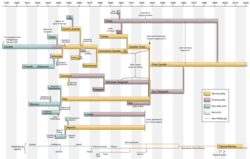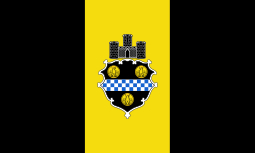Media in Pittsburgh
Pittsburgh is home to the first commercial radio station in the United States, KDKA 1020AM; the first community-sponsored television station in the United States, WQED 13; the first "networked" television station and the first station in the country to broadcast 24 hours a day, 7 days a week, KDKA 2; and the first newspaper published west of the Allegheny Mountains, the Pittsburgh Post-Gazette. Until 2016 Pittsburgh was one of the few mid-sized metropolitan areas in the U.S. with two major daily papers; both the Pittsburgh Post-Gazette and the Pittsburgh Tribune-Review have histories of breaking in-depth investigative news stories on a national scale. In 2016, the Tribune-Review moved to an all-digital format. The Post-Gazette moved to publishing five print editions a week in 2018 and three print editions a week in 2019. The alternative papers in the region include the Pittsburgh City Paper; The Jewish Chronicle of Pittsburgh; The New People, published weekly by the Thomas Merton Center for Peace and Social Justice; the New Pittsburgh Courier, one of the larger ethnic publications in the region; and Zajedničar, the only Croatian-language newspaper currently published in the United States. The Pitt News, a financially independent student-written and -managed newspaper of the University of Pittsburgh, is closing in on its 100th year of publication. The University of Pittsburgh School of Law also hosts JURIST, the world's only university-based legal news service.
Newspapers

- Major newspapers:
- Alternative newspapers:
- Specialty newspapers:
- The Bulletin
- The Front Weekly
- The Jewish Chronicle of Pittsburgh
- The New People
- Northside Chronicle
- Pittsburgh Business Times
- Pittsburgh Catholic
- Pittsburgh Courier (African-American community)
- South Pittsburgh Reporter
- Zajedničar
- Academic newspapers:
- Online newspapers:
- The Incline
- Jekko
- NEXTPittsburgh
Magazines and journals
- Variety:
- Jenesis Magazine
- LOCALPittsburgh Magazine
- Pittsburgh Magazine
- Pittsburgh Quarterly
- WHIRL Magazine
- Academic:
- Contemporaneity: Historical Presence in Visual Culture (digital journal) [1]
- Creative Nonfiction (magazine)
- Hot Metal Bridge
- Journal of Law and Commerce
- Pittsburgh Journal of Environmental and Public Health Law
- Pittsburgh Journal of Technology Law & Policy
- Pittsburgh Tax Review
- Sampsonia Way Magazine
- Three Rivers Review
- University of Pittsburgh Law Review
Television
The Pittsburgh TV market is currently ranked as the 23rd largest in the United States by Nielsen.[2] It has recently gained distinction as one of the most competitive.[3] (In the listing below the table, network O&O's are denoted in bold.) The market is served by:
| Channel | Call Sign | Network | Since | Digital subchannel | Digital Subchannel | Owner |
|---|---|---|---|---|---|---|
| 2 | KDKA | CBS | 1949 (Jan. 11) |
Start TV | CBS | |
| 4 | WTAE | ABC | 1958 (Sept. 14) |
Cozi TV | -- | Hearst |
| 11 | WPXI | NBC | 1957 (Sept. 1) |
Me-TV | -- | Cox Media |
| 13 | WQED | PBS | 1954 (Apr. 1) |
Create | Neighborhood | |
| 16 | WEPA-CD | Cozi TV | 1989 (Feb. 28) |
Movies! | OTA Broadcasting | |
| 19 | WPCW | The CW | 1953 (Oct. 15) |
CBS | ||
| 22 | WPNT | MyTV | 1978 (Sept. 26) |
Sinclair | ||
| 29 | WIIC | 1989 (Aug. 29) |
Abacus Television | |||
| 35 | WBYD-CA | JTV | 1990 (Jul. 25) |
Perez Broadcasting | ||
| 38 | WINP | ION | 1953 (Aug. 31) |
Qubo | IonLife | Ion Media |
| 50 | WPCB | Cornerstone | 1979 (Apr. 15) |
Cornerstone | ||
| 53 | WPGH | Fox | 1953 (July 14) |
ZUUSCountry | Sinclair | |
| PCNC | 1994 (Jan. 1) |
Cox Media | ||||
| AT&T SportsNet | FoxSports | 1986 (Apr. 13) |
AT&T Sports Networks | |||
| PanthersTV | Pitt | 2010 (Sep. 21) |
|
|
|
|
Radio
Pittsburgh radio has long been dominated by KDKA 1020 AM. However, as of early 2006 the station is no longer No. 1 in the ratings. KQV 1410 AM, now an all-news outlet, was Pittsburgh's dominant Top 40 station throughout the 1960s. On the FM dial, album-rock WDVE (102.5 DVE), modern rock WXDX (105.9 The X), adult contemporary WBZZ (Star 100.7), pop and hip-hop WKST-FM (96.1 KissFM) and Pittsburgh Sports Talk on (93.7 The Fan) KDKA-FM FM talk radio is available in the Pittsburgh market at WPGB (104.7 FM NewsTalk). Pittsburgh is also home to three public radio stations: WESA, the local NPR station; WQED-FM, a listener-supported commercial-free classical music station; and WYEP 91.3FM, the nation's third-largest independent "adult album alternative" (AAA) station, which hosts the locally produced environmental radio show The Allegheny Front and also carries some NPR programming. The Radio Information Service, broadcasting on a subcarrier of WESA provides special programming for the blind and print impaired. Additionally, Pittsburgh hosts the non-commercial radio stations WRCT (affiliated with Carnegie Mellon University) and WPTS (affiliated with the University of Pittsburgh).
DMA
In 2010, Nielsen will continue to rank Pittsburgh as the 23rd largest television Designated Market Area (DMA) in the country, with 1,154,950 households. That is a drop from Nielsen's 2009 estimate of 1,156,460. Despite the decline in households, Pittsburgh still has 22,090 more households than the next closest television DMA which is Charlotte, NC.[4] [5]
In 2004 Pittsburgh was the 24th largest DMA in the U.S. as ranked by population, with a population of 2,881,200.[6] Pittsburgh's DMA covers a land area of 10,083 square miles (26,110 km2) in three states.
Other definitions of the "Pittsburgh region" extend into Ohio border counties with some sources including several Ohio counties and as far south & west as the Kentucky border and north into the extreme southwest of New York State.
The Pittsburgh DMA includes the following counties:
Pennsylvania counties:
West Virginia counties:
Maryland counties:
References
- "Contemporaneity: Historical Presence in Visual Culture". contemporaneity.pitt.edu. Retrieved 2019-06-13.
- http://www.nielsen.com/content/dam/corporate/us/en/public%20factsheets/tv/nielsen-2012-local-DMA-TV-penetration.pdf
- Pittsburgh TV News Is A Tight 3-Way Race. TVNewsCheck.com. Retrieved on 2013-07-23.
- "Nielsen 2009-2010 Local Television Market Universe Estimates" (PDF). Archived from the original (PDF) on 2011-03-17. Retrieved 2009-08-28.
- "114.9 Million U.S. Television Homes Estimated for 2009-2010 Season". Retrieved 2009-08-28.
- "Pittsburgh. A top 25 metro" (PDF). Pittsburgh Post-Gazette. Retrieved 2007-01-20.
